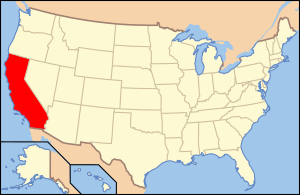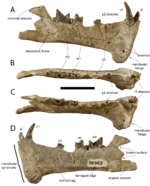Paleontology in California facts for kids

Paleontology in California is all about studying ancient life in the state of California. Scientists called paleontologists look for fossils here. California has rocks from almost every time period, from the very, very old Precambrian era to today.
Long ago, during the early Paleozoic Era, much of California was covered by a warm, shallow sea. This sea was home to many creatures without backbones, like ammonites, brachiopods, corals, and trilobites. Later, during the Carboniferous and Permian periods, parts of California that were no longer underwater became swamps.
In the Mesozoic Era, California still had both ocean and land environments. In the seas, you could find ammonites, marine reptiles, and oysters. On land, dinosaurs walked among plants like cycads and conifers.
During the Cenozoic Era, sea levels changed a lot. California became home to different environments, including shallow seas, estuaries (where rivers meet the sea), and dry land. Amazing creatures lived here, such as ancient camels, three-toed horses, mastodonts, oreodonts, saber-toothed cats, ground sloths, and dire wolves.
Long ago, Native Americans in California told stories about the fossils they found. Many of these stories were similar to what modern science later discovered. Scientists started studying California's fossils in the mid-1800s. One of the most famous fossil sites is the La Brea tar pits, which has many Pleistocene mammal fossils. The Pleistocene saber-toothed cat, Smilodon fatalis, is the official California state fossil.
Contents
Ancient Life in California
Life in the Paleozoic Era
Fossils from the Precambrian era are very rare in California. But during the early Paleozoic Era, California was mostly covered by a warm, shallow sea. This sea was full of marine invertebrates. These included ammonites, brachiopods, and corals. At least two types of trilobites lived in San Bernardino County during the Early Cambrian period.
By the Mississippian period, brachiopods and corals were common. Later, during the Carboniferous and Permian periods, northern California had many different environments. There were deep and shallow seas, estuaries, and swamps in places like Butte and Shasta Counties. Corals and brachiopods continued to thrive in the state during the Pennsylvanian period.
Life in the Mesozoic Era
The Mesozoic Era was a time of big changes in California's geology. Mountains formed, and volcanoes were active. The Sierra Nevada mountains began to rise during this time. California had both marine and land environments.
The ancient seas were home to many different marine invertebrates and marine reptiles. On land, plants like conifers, cycads, and ginkgoes grew. Tiny creatures called Radiolaria were common in California during the Jurassic period. Some of the best radiolaria fossils are found in Golden Gate Park.
During the Cretaceous period, invertebrates like ammonites and pearl oysters lived in California's seas. Both coiled and uncoiled ammonites are found in Late Cretaceous rocks. Later in the Late Campanian and Maastrichtian periods, advanced mosasaurs, like Plesiotylosaurus and Plotosaurus, swam in California's waters. On land, many types of dinosaurs roamed the state. These included the ankylosaur Aletopelta and many duck-billed dinosaurs, especially Augustynolophus.
Life in the Cenozoic Era
California continued to be very geologically active into the Cenozoic Era. The Coast and Transverse Mountains formed during this time. Sea levels went up and down, creating various environments like shallow seas, estuaries, and dry land.
More than 2,300 types of Tertiary insects have been found in California's ancient tar deposits. In the Middle Eocene, California's invertebrates included corals, gastropods (snails), and pelecypods (clams). Some of these corals lived alone. Oligocene plant fossils include leaves, fruit, and petrified wood.
During the Middle Miocene, Los Angeles County had many different marine invertebrates, like gastropods and pelecypods. Many of these fossils are very well preserved. Acorn barnacles from the Middle Miocene are found in Santa Clara County. In the Late Miocene, huge 18-inch long oysters lived in Contra Costa County. Freshwater snails and clams were preserved in Sonoma County. Sand dollars also lived in California during the Late Miocene.
California was also home to aquatic mammals like the dugongid Dusisiren and the desmostyle Paleoparadoxia during the Miocene. At the end of the Miocene and beginning of the Pliocene, many modern trees grew around the San Francisco Bay Area. These included alder, cherry, dogwood, elm, magnolia, oak, poplar, and willow.
Many Pliocene plants are known from San Francisco. During the early Pliocene, the Berkeley Hills area had creatures like camels, horses, mastodonts, and oreodonts. Near Mount Diablo, fossils from the same time show at least three types of camels, cranes, a fox, a small beaver, horses (with the three-toed horse Hipparion forcei being common), hyena-like animals, and many mastodonts. There were also mountain lion-like cats, peccaries, rabbits, and possible saber-toothed cats.
The Middle Pliocene had creatures like bear dogs, various camels, flamingos, ground sloths, mastodons, pronghorns, two types of rhinoceros, and small rodents. By the late Pliocene, many of California's modern animals appeared, but there were also giant tortoises. Marine invertebrates like pelecypods and gastropods are known from the Pliocene in the Scotia–Eureka area. Ark shells were also found in many places across California during the Late Pliocene.
By the Quaternary period, California's wildlife looked much more like today's. The landscape had lakes, rivers, and glaciers. Local animals included camels, saber-toothed cats, and mammoths. Many Pleistocene invertebrates have been found near Ventura.
The Black Hawk Ranch fossil site is considered the best early Pleistocene animal collection west of the Rocky Mountains. Fossils from Black Hawk Ranch include camels, early coyotes, deer, elk, horses, relatives of modern musk oxen, a unique pronghorn antelope, rodents, saber-toothed cats, and dire wolves.
Pleistocene plant fossils are common in the Bay Area. Twelve types of modern trees are known from near Tomales. Other Pleistocene plants include the southernmost examples of coast redwoods and amazing Douglas fir specimens, some with trunks six feet wide, complete with seeds and needles. Other Pleistocene invertebrates included hardshell cockles, spiny cockles, and oysters. Late Pleistocene fossils are found all over California.
Discovering Fossils in California
Scientific Research and Big Finds
In 1856, a new fossil site was found in Contra Costa County, preserving 18-inch oysters. This site became known as the Pecten Beds. Between 1906 and 1916, hundreds of thousands of Pleistocene fossils were dug up in central Los Angeles, mostly from the La Brea tar pits.
In 1942, early Pleistocene fossils were discovered in gravel pits at Irvington. In 1963, Samuel Paul Welles from the University of California, Berkeley found a very complete fossil of a dugongid called Dusisiren. This was the most complete Miocene sirenian (sea cow relative) ever found.
On October 2, 1964, during excavations at Stanford University, scientists found the nearly complete skeleton of an aquatic desmostyle mammal called Neoparadoxia. This skeleton had 175 of its 200 bones. It was only the second such specimen found worldwide and the first in North America. This discovery was considered one of the most important finds in North American paleontology.
Famous Paleontologists from California
Born in California
- Joseph T. Gregory was born in Eureka on July 28, 1914.
- Thomas R. Holtz, Jr. was born in Los Angeles in 1965.
- Malcolm McKenna was born in Pomona in 1930.
- Richard H. Tedford was born in Encino on April 25, 1929.
Passed Away in California
- Annie Montague Alexander died in Oakland on December 10, 1950 at age 82.
- Roy Chapman Andrews died in Carmel-by-the-Sea on March 11, 1960 at age 76.
- Charles Lewis Camp died in San Jose on 14 August 1975.
- Ulysses S. Grant IV died in Santa Monica on March 11, 1977.
Natural History Museums to Visit
- Children's Natural History Museum, Fremont
- Berkeley Natural History Museums, Berkeley
- Bowers Museum, Santa Ana
- Buena Vista Museum of Natural History, Bakersfield
- California Academy of Sciences, San Francisco
- California Mining and Mineral Museum, Mariposa
- George C. Page Museum at the La Brea Tar Pits, Los Angeles
- Humboldt State University Natural History Museum, Arcata
- Humboldt State University Wildlife Museum, Arcata
- Imperial Valley College Desert Museum, Ocotillo
- Maturango Museum, Ridgecrest
- Morro Bay State Park Museum of Natural History, Morro Bay
- Natural History Museum of Los Angeles County, Los Angeles
- Oakland Museum of California, Oakland
- Pacific Grove Museum of Natural History, Pacific Grove
- Randall Museum, Corona Heights Park, San Francisco
- Raymond M. Alf Museum of Paleontology, Claremont
- San Diego Natural History Museum, San Diego
- Santa Barbara Museum of Natural History, Santa Barbara
- Santa Cruz Museum of Natural History, Santa Cruz
- Sierra College Natural History Museum, Rocklin
- University of California Museum of Paleontology, Berkeley
- Western Science Center, Hemet
Paleontology Clubs and Groups
- Southern California Paleontological Society
- Fossils for Fun Society, Inc.
- San Diego Mineral and Gem Society






